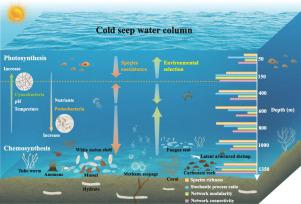当前位置:
X-MOL 学术
›
Sci. Total Environ.
›
论文详情
Our official English website, www.x-mol.net, welcomes your
feedback! (Note: you will need to create a separate account there.)
Community assemblages and species coexistence of prokaryotes controlled by local environmental heterogeneity in a cold seep water column
Science of the Total Environment ( IF 8.2 ) Pub Date : 2023-01-18 , DOI: 10.1016/j.scitotenv.2023.161725 Yongji Huang 1 , Jing-Chun Feng 2 , Jie Kong 3 , Liwei Sun 2 , Mingrui Zhang 2 , Yanyan Huang 2 , Li Tang 2 , Si Zhang 4 , Zhifeng Yang 2
Science of the Total Environment ( IF 8.2 ) Pub Date : 2023-01-18 , DOI: 10.1016/j.scitotenv.2023.161725 Yongji Huang 1 , Jing-Chun Feng 2 , Jie Kong 3 , Liwei Sun 2 , Mingrui Zhang 2 , Yanyan Huang 2 , Li Tang 2 , Si Zhang 4 , Zhifeng Yang 2
Affiliation

|
The distribution and heterogeneity characteristics of microbial communities in cold seep water columns are significant factors governing the efficiency of methane filtering and carbon turnover. However, this process is poorly understood. The diversity of vertically stratified microbial communities and the factors controlling the community assemblage process in the water column above the Haima cold seep were investigated in this study. The prokaryotic community diversities varied distinctly with vertical changes in hydrochemistry. Cyanobacteria dominated the light-transmitting layers and Proteobacteria dominated the deeper layers. With respect to microbial community assemblages and co-occurrence networks, stochastic processes were particularly important in shaping prokaryotic communities. In the shallow (≥85 m) and mesopelagic water columns (600–800 m), microbial community characteristics were affected by deterministic processes, reduced network connectivity, and modularity. Microbial community diversities and assemblage processes along a vertical profile were influenced by the vertical variations in pH, temperature, DIC, and nutrients. Stochastic processes may have facilitated the formation of complex co-occurrence networks. Briefly, the distribution of local environmental heterogeneity along the vertical dimension could drive unique microbial community assemblage and species coexistence patterns. This study provides new perspectives on how microorganisms adapt to the environment and build communities, and how species coexist in shared habitats.
更新日期:2023-01-18

































 京公网安备 11010802027423号
京公网安备 11010802027423号